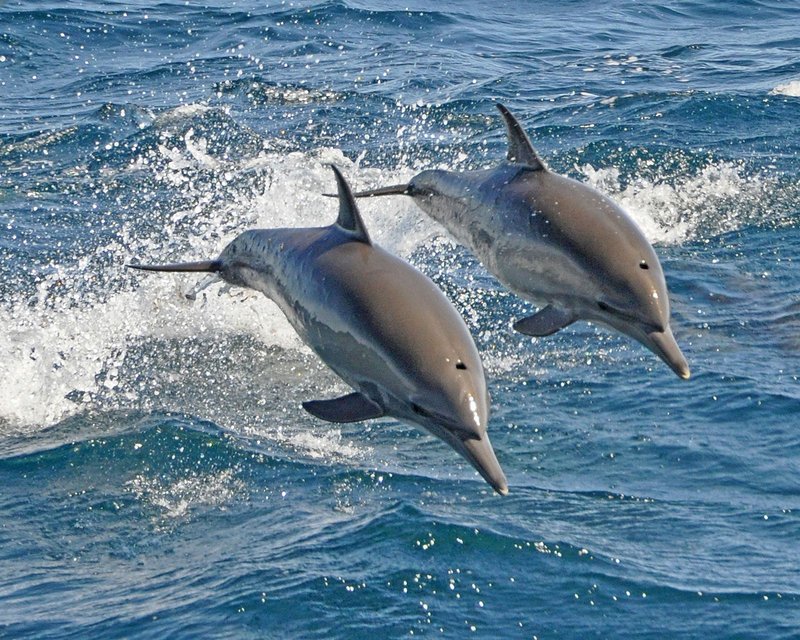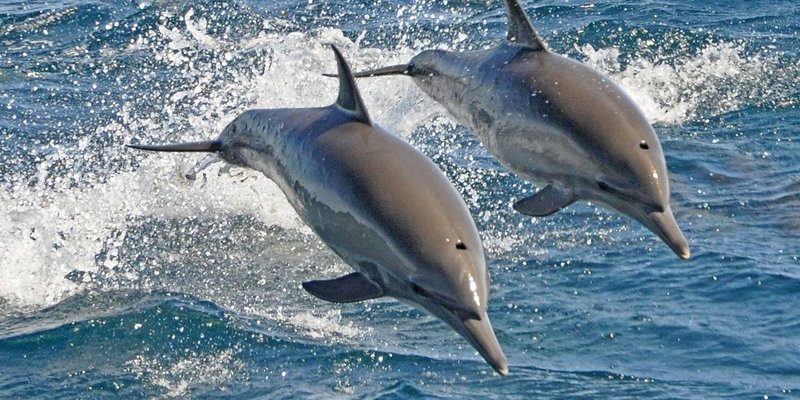
What Are Dolphins?
Dolphins are fascinating marine mammals known for their intelligence, playful behavior, and social nature. Imagine swimming in the ocean and suddenly encountering a sleek creature slicing through the water with grace. That’s a dolphin! These animals belong to the family Delphinidae, which includes around 30 different species, such as the well-known bottlenose dolphin and the majestic orca. They can be found in oceans and seas around the world, from tropical waters to cooler regions.
In addition to their charming appearance, dolphins are recognized for their strong social bonds. They often swim in pods, which are groups of dolphins that travel together. Just like you might enjoy hanging out with friends, dolphins thrive on companionship and communication. They use a complex system of clicks, whistles, and body language to express themselves and coordinate activities like hunting or playing.
Dolphins have a unique blend of physical characteristics that make them exceptional swimmers. Their streamlined bodies, powerful tails, and sophisticated echolocation abilities allow them to navigate through the water with effortless agility. This ability to “see” their surroundings using sound is not only intriguing but also essential for finding food and avoiding obstacles.
Physical Characteristics
Dolphins have a range of physical features that help them thrive in their aquatic environment. On average, they can grow anywhere from about 5 to 30 feet in length, depending on the species. For instance, bottlenose dolphins usually measure around 8 to 12 feet long, while orcas can reach up to 30 feet! Imagine standing next to a long school bus—that’s the size of an orca in comparison!
Their skin is smooth and typically gray, often with lighter underbellies. This coloration serves a purpose; it provides a form of camouflage when viewed from above or below. When a dolphin swims, it blends in with the ocean’s surface when seen from above, while from below, it merges with the lighter ocean floor. This natural design helps them elude predators and approach prey without being noticed.
Another remarkable feature is their dorsal fin, which is located on their back and varies in shape and size among different species. This fin not only helps with stability while swimming but also serves as a way for dolphins to communicate. You might even notice dolphins leaping out of the water and twisting in the air, a behavior known as porpoising. It’s like watching a graceful ballet performance, showcasing their strength and agility.
Habitat and Distribution
Dolphins inhabit a vast range of environments, from coastal areas to deep ocean waters. You might find them in warm tropical seas, temperate regions, and even some colder waters, although their preference leans towards warmer climates. They are highly adaptable, thriving in both shallow waters near shores and deeper oceanic expanses.
One of the most interesting aspects of dolphin distribution is their tendency to migrate based on food availability and breeding habits. For example, certain species, like the common dolphin, often follow schools of fish to ensure a steady supply of food. They can travel long distances, sometimes up to hundreds of miles, just in search of a good meal.
When it comes to specific habitats, dolphins are often found near coral reefs, estuaries, and even rivers in some cases. The Amazon River dolphin is a perfect example of a species that has adapted to freshwater life. This adaptability speaks volumes about their resilience and intelligence as they navigate different environments.
Diet and Feeding Habits
Dolphins are carnivorous, mainly feeding on fish, squid, and sometimes crustaceans. Picture a dolphin hunting—its echolocation clicks echoing through the water, locating schools of fish with pinpoint accuracy. Once they have found their prey, they use various strategies to catch it.
Dolphins often work together in their pods to herd schools of fish into tighter groups, making it easier to feast. This cooperative hunting behavior showcases their intelligence and social nature. They might even take turns diving deep below the surface or surfacing together to catch fish in bursts, demonstrating a level of teamwork often seen in human activities.
One fascinating feeding method employed by dolphins is called “strand feeding.” In this technique, they chase fish onto mudflats or beaches, allowing them to catch their prey in shallow water. Imagine a dolphin leaping just as it reaches the shore, scooping up fish in an impressive display of agility and skill. This behavior highlights not only their resourcefulness but also their ability to adapt to their surroundings.
Communication and Social Structure
Dolphins are known for their exceptional communication skills. They use a series of clicks, whistles, and body movements to share information and express emotions. When you hear a dolphin vocalizing, it’s as if they’re having a lively conversation with their pod. These sounds serve various purposes, from signaling danger to coordinating hunting efforts.
Their social structure is equally fascinating. Dolphins live in complex societies, often led by a dominant female known as the matriarch. This female plays a crucial role in making decisions for the group, such as when to migrate or where to find food. Here’s the thing: dolphins not only bond with their relatives but also form friendships with other dolphins. They often show empathy and care towards one another, reinforcing social ties through playful activities and grooming.
The relationships within dolphin pods can be quite intricate. They establish strong bonds that can last for years, with mothers typically nurturing their calves for several years, teaching them vital survival skills. You may even notice dolphins engaging in playful behaviors, like surfing on waves or playing with seaweed, which strengthens these social connections.
Intelligence and Behavior
Dolphins are often regarded as some of the most intelligent animals on the planet. Their brain-to-body ratio and complex behaviors display remarkable cognitive abilities. Studies have shown that dolphins possess problem-solving skills, self-awareness, and even the ability to learn through observation—traits that are quite similar to humans.
You might be amazed to learn about their ability to recognize themselves in mirrors, which indicates a level of self-awareness. This phenomenon is often tested in various species, but only a few, including dolphins, pass this challenging assessment. It’s like they have a sense of identity, an understanding of their place in the world.
In the wild, dolphins exhibit various behaviors that indicate their intelligence. They can create and use tools, such as covering their snouts with sponges while hunting on the ocean floor to protect themselves. This ability to innovate showcases their resourcefulness and adaptability—qualities that have allowed them to thrive in various environments.
Reproduction and Lifespan
Dolphin reproduction occurs after a gestation period that varies by species but generally lasts about 11 to 12 months. After this time, a calf is born, typically measuring around three to four feet in length. The bond between a mother and her calf is incredibly strong. Mothers are devoted, nurturing their young and teaching them essential skills for survival.
Females typically give birth to one calf every two to three years, which allows them enough time to care for their young. A calf often stays with its mother for several years, learning not just how to hunt but also the social dynamics of pod life. You might think of this relationship like a parent teaching their child how to thrive in the world.
Dolphins have varying lifespans depending on the species, with some living 20 to 60 years in the wild. Captive dolphins can sometimes live longer, but they generally face different health challenges in their restricted environments. The oldest recorded dolphin was a bottlenose dolphin named “Bottlenose”, who lived to be over 60 years old. This longevity speaks to their resilience and adaptability—but it also raises questions about the threats they face in our oceans today.
Conservation Status
While dolphins are iconic creatures, they face numerous challenges in today’s world. Many species are threatened by habitat loss, pollution, climate change, and fishing practices that inadvertently capture them. It’s concerning to think that these intelligent beings could be in danger due to human actions.
Organizations and conservationists are working tirelessly to protect dolphins and their habitats. Efforts range from advocating for cleaner oceans to establishing marine protected areas where dolphins can thrive without human interference. Education plays a crucial role in these initiatives, helping people understand the importance of preserving the delicate ecosystems that support dolphin populations.
You might have heard about initiatives like the Marine Mammal Protection Act, which aims to safeguard dolphins and other marine life from harm. These laws help regulate fishing practices and limit activities that could negatively impact dolphin habitats. It’s a small step, but every bit of effort counts.
FAQ
Are dolphins fish or mammals?
Dolphins are mammals, not fish. Unlike fish, dolphins breathe air through lungs and give live birth to their young. They are warm-blooded, have a layer of fat called blubber for insulation, and nurse their calves with milk. These traits classify them among the marine mammals known as cetaceans, which also include whales and porpoises.
How long can dolphins hold their breath?
Dolphins can hold their breath for about 10 to 20 minutes, depending on the species and activity level. They often surface every few minutes for a quick breath, especially when swimming or engaging in social activities. Their ability to stay underwater for extended periods is impressive, but they need regular access to the surface to breathe.
Are dolphins dangerous to humans?
Generally, dolphins are not dangerous to humans and are often perceived as friendly creatures. However, it’s essential to remember that they are wild animals and can exhibit unpredictable behavior. Approaching dolphins in their natural habitats should always be done with caution and respect for their space.
Can dolphins recognize each other?
Yes, dolphins can recognize each other! They have unique whistles that serve as their names, allowing them to identify one another. This recognition plays a significant part in their social structure and helps maintain bonds within pods.
Do dolphins sleep?
Yes, dolphins do sleep, but they have a unique method of doing so. They cannot breathe automatically like humans do, so they rest one hemisphere of their brain at a time. This way, they can continue swimming and surfacing for air while getting the rest they need.
How fast can dolphins swim?
Dolphins can swim at speeds of up to 25 mph, depending on the species. They often use their speed to escape predators or chase prey. Watching a dolphin leap out of the water in a burst of speed is truly a mesmerizing sight!
What is the largest species of dolphin?
The orca, or killer whale, holds the title for the largest dolphin species. Males can reach lengths of up to 30 feet and weigh as much as 12,000 pounds! Despite the name “whale,” orcas belong to the dolphin family and exhibit many of the same characteristics.
Do dolphins communicate with other species?
While dolphins primarily communicate within their species, there are anecdotal accounts of them interacting and communicating with other marine animals, such as sea lions. These interactions often involve playful behavior, indicating a level of social intelligence.
How do dolphins keep warm in cold waters?
Dolphins have a thick layer of blubber beneath their skin that insulates them against the cold. This blubber can be several inches thick, depending on the species and environment, allowing them to maintain their body temperature even in chilly waters.
Can dolphins be trained?
Yes, dolphins are highly trainable due to their intelligence and social nature. Trainers often use positive reinforcement techniques, rewarding dolphins for desired behaviors. This ability to learn and adapt makes them popular in marine parks and educational programs, although it’s essential to prioritize their well-being and natural behaviors in these settings.

